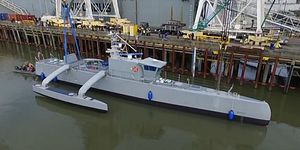Last week, the Advanced Research Projects Agency (DARPA), a Pentagon agency responsible for developing and testing cutting-edge military technologies, released a video of its Anti-Submarine Warfare (ASW) Continuous Trail Unmanned Vessel (ACTUV) depicting the ship being launched and undergoing speed tests earlier this year. The 132-feet (40 meters) long and 140-ton heavy ACTUV is an unmanned autonomous trimaran prototype.
“The ACTUV technology demonstration vessel was recently transferred to water at its construction site in Portland, Ore., and conducted speed tests in which it reached a top speed of 27 knots (31 mph/50 kph),” according to a DARPA press release. “The vessel is scheduled to be christened on April 7, 2016, with open-water testing planned to begin in summer 2016 off the California coast.”
Immediately following the christening of the ACTUV at the Vigor Shipyards in Oregon, the ship will commence extensive open-water trials for 18 months in California. The sea-trials will also involve testing the vessel’s long-range tracking capabilities. Throughout this next testing phase, DARPA will closely liaison with the Office of Naval Research and the Space and Naval Systems Warfare Command.
As I explained in February, the ACTUV is specifically designed to track quiet diesel-electric submarines (See: “World’s Largest Anti-Submarine Robot Ship Ready for Sea-Trials in April”):
The ship’s primary mission will be tracking enemy subs in shallow waters. Furthermore, (…) the ACTUV is designed to operate autonomously for 60 to 90 days straight, surveil large stretches of ocean territory and — should an enemy sub be spotted — guide other U.S. naval assets to the vessel’s location to destroy it (the ACTUV itself is unarmed).
DARPA’s website notes that the ACTUV program objective “is to generate a vessel design that exceeds state-of-the art platform performance to provide propulsive overmatch against diesel electric submarines at a fraction of their size and cost.” (The ACTUV will approximately cost $15,000 to $20,000 per day to operate.)
The ACTUV is equipped with a Raytheon Modular Scalable Sonar System (MS3), the vessel’s primary search-and-detection sonar and purportedly the first fifth-generation medium-frequency hull-mounted sonar system built by the U.S. defense contractor. The MS3 is designed to autonomously conduct active and passive sonar searches.
The ACTUV allegedly has already successfully tracked a submarine from one kilometer (0.62 miles) away. DARPA is also working on developing non-conventional sensor technologies to facilitate the correct identification of surface ships and other objects while at sea. Throughout its missions at sea, the ACTUV will be in constant contact with other ships or aircraft via satellite link. The robot ship prototype will serve as the basis for a whole fleet of cheap sub-hunting drone ships.

































